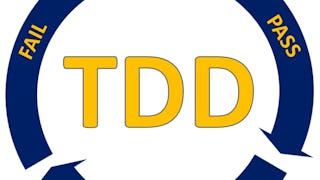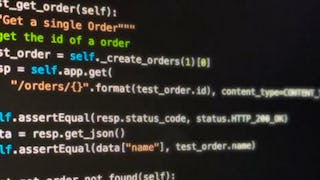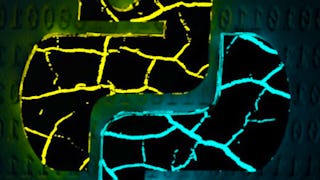In this course we will discuss how to integrate best practices of test-driven development into your programming workflow. We will start out by discussing how to refactor legacy codebases with the help of agile methodologies. Then, we will explore continuous integration and how to write automated tests in Python. Finally, we will work everything we've learned together to write code that contains error handlers, automated tests, and refactored functions.


Integrating Test-Driven Development into Your Workflow
This course is part of Test-Driven Development Specialization

Instructor: Doug Purcell
Included with
(12 reviews)
Skills you'll gain
Details to know

Add to your LinkedIn profile
8 assignments
See how employees at top companies are mastering in-demand skills

Build your subject-matter expertise
- Learn new concepts from industry experts
- Gain a foundational understanding of a subject or tool
- Develop job-relevant skills with hands-on projects
- Earn a shareable career certificate

There are 4 modules in this course
Legacy code is code written by others that’s inherited by a team or programmer. The issue working with legacy code is that it can often be difficult and time consuming to update and maintain. Learn some proven techniques on how to refactor your legacy code with the help of agile methodologies such as unit tests and test driven development.
What's included
4 videos1 reading2 assignments1 discussion prompt1 ungraded lab
Continuous integration (CI) is a pillar in modern software development. It’s the process in which a code base is rapidly developed during the course of the business day.
What's included
2 videos1 reading2 assignments1 discussion prompt1 ungraded lab
Continuous delivery is taking the steps to be able to have your software delivered at any time. It’s similar to continuous deployment with the distinction that it is manual as opposed to automated. In this section we’ll take a closer look at continuous delivery and how it intertwines with a related concept of continual deployment.
What's included
2 videos1 reading2 assignments1 discussion prompt1 ungraded lab
Exception handling is a way for coders to help make their code less vulnerable to errors. A proactive developer will consider invalid input that a user may enter into a program and process this error gracefully.
What's included
2 videos1 reading2 assignments1 discussion prompt1 ungraded lab
Earn a career certificate
Add this credential to your LinkedIn profile, resume, or CV. Share it on social media and in your performance review.
Instructor

Offered by
Explore more from Software Development
 Status: Free Trial
Status: Free Trial Status: Free Trial
Status: Free TrialLearnQuest
 Status: Free Trial
Status: Free Trial
Why people choose Coursera for their career




Learner reviews
12 reviews
- 5 stars
41.66%
- 4 stars
25%
- 3 stars
16.66%
- 2 stars
0%
- 1 star
16.66%
Showing 3 of 12
Reviewed on Apr 23, 2021
In general, this module is nice to know, but quizes is really boring and labs are too simple, therefore overall value is not very high.

Open new doors with Coursera Plus
Unlimited access to 10,000+ world-class courses, hands-on projects, and job-ready certificate programs - all included in your subscription
Advance your career with an online degree
Earn a degree from world-class universities - 100% online
Join over 3,400 global companies that choose Coursera for Business
Upskill your employees to excel in the digital economy
Frequently asked questions
To access the course materials, assignments and to earn a Certificate, you will need to purchase the Certificate experience when you enroll in a course. You can try a Free Trial instead, or apply for Financial Aid. The course may offer 'Full Course, No Certificate' instead. This option lets you see all course materials, submit required assessments, and get a final grade. This also means that you will not be able to purchase a Certificate experience.
When you enroll in the course, you get access to all of the courses in the Specialization, and you earn a certificate when you complete the work. Your electronic Certificate will be added to your Accomplishments page - from there, you can print your Certificate or add it to your LinkedIn profile.
Yes. In select learning programs, you can apply for financial aid or a scholarship if you can’t afford the enrollment fee. If fin aid or scholarship is available for your learning program selection, you’ll find a link to apply on the description page.
More questions
Financial aid available,


